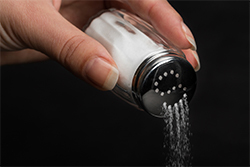Give a boost to your health by lowering your salt intake

Here we are, nearing the beginning of a new year — a fresh start and a renewed opportunity to do things better than before. Topping the list of many people’s resolutions: living a healthier lifestyle, which typically starts with diet. Katie Campbell, RD, CDN, a registered dietitian at NewYork-Presbyterian Lawrence Hospital in Bronxville, discusses how something as simple as reducing sodium intake can boost your health by lowering your numbers — everything from blood pressure to weight.
Why should reducing salt intake be part of a healthy eating plan?
Even if you currently don’t have high blood pressure, it is important to monitor your sodium intake to prevent a rise in blood pressure that can occur naturally with age. High blood pressure can lead to a multitude of other health conditions so taking preventative measures are essential in living a long and healthy life.
What are the health dangers of too much salt?
A diet high in salt can cause a host of conditions, particularly high blood pressure, which can lead to heart attack, stroke, heart failure, kidney disease, and osteoporosis. Too much salt in the diet also makes the body retain water, which gives us that bloated feeling and can contribute to weight gain.
What are the latest USDA guidelines for daily sodium intake?
The average American should have less than 2,300mg per day and ideally less than 1,500mg per day, especially if you already have hypertension or prehypertension. The guidelines do not differ per age or gender.
Why is some salt/sodium important in the diet?
Sodium is a mineral that is essential for life, but your body only requires 500mg per day, which is easy to achieve.
Which foods are typically high in salt and should be avoided?
Let’s face it: salt tastes good and helps bring out the flavor in foods. But it’s significant to note that seventy-five percent of the sodium we, as Americans, consume comes from processed, prepackaged foods and restaurant food. The American Heart Association also identifies the “Salty Six” — bread and rolls, pizza, soup, sandwiches, cold cuts and cured meats, and poultry. Limiting these foods by cooking at home and incorporating more fresh ingredients, can drastically reduce sodium intake. Remember, it’s impossible to completely eliminate sodium, but the goal is to make healthier, more mindful choices to reduce your overall intake.
Can you offer some tips for reducing salt in the diet – without sacrificing flavor?
Here are some effective ways I always recommend:
- Always read labels and try to stay within the 2,300mg per day guideline
- Prepare your own foods and avoid purchasing convenience foods such as canned soups, frozen dinners, instant cereals, and gravy sauce mixes.
- Purchase fresh items – fresh fruits, vegetables, whole grains, and meat and seafood products. Check the packaging on meat and seafood to see if salt water or saline has been added.
- Choose condiments wisely. Many condiments are packed with sodium. Read labels and always look for the reduced or low sodium versions.
- Buy unsalted snack items.
- Drain and rinse canned vegetables and beans.
- Always use low sodium versions to cook with such as low sodium chicken stock.
- If you go out to eat, specify how you want your food prepared, for example, ask for sauce or dressing on the side. And look for key words such as pickled, brined, cured, smoked, soy sauce or teriyaki sauce — these words mean the food will be higher in sodium content.
Try a homemade spice blend with no salt. Two examples:
Cajun Spice Blend
2T Cumin
2T Coriander
2T Paprika
1 1/2t Black Pepper
Cayenne Pepper to taste
1T Dried Oregano
Use on chicken, fish, shrimp, steak, & thick cut veggies
Greek Spice Blend
1T Garlic Powder
1T Dried Basil
1T Dried Oregano
1-1/2t Black Pepper
1-1/2t Dried Parsley
1-1/2t Dried Rosemary
1-1/2t Dried Thyme
Use on veggies, chicken, pork, beef, or lamb
To try more tasty and nutritious recipes, visit nyp.org/nutrition. To find a primary care doctor, please call 877-697-9355.



